Elevate Your Space: 5 Trending Furniture and Décor Ideas for Events
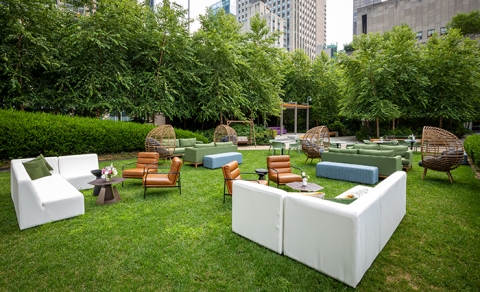
On July 30, event-furniture rental giant CORT Events invited 200 industry leaders and tastemakers to a five-hour, garden-themed open house event on the 9th floor of New York City’s iconic Rockefeller Plaza. The to-do drew inspiration from the venue’s adjacent alfresco event space—where a foliage-filled oasis was a reprieve from the traffic below—and boasted setups throughout of different seating, table-and-chair, and decor arrangements for guests to both ogle over and mingle in.
Here are the five noteworthy trends that CORT chose to display, plus insights the company’s executive director of marketing and merchandising, Kevin Dana, dished to TSNN onsite.
1. Outdoor offerings
When asked what CORT’s most popular pieces currently are, Dana said: “I think we should start with outdoor products in general because since the pandemic, a lot of events moved outside for reasons we all know. Since then, though, outdoor products and outdoor events have become more popular year-round.”
Speaking to the trend, Dana noted that just a few years ago, less than 10% of CORT’s inventory included outdoor offerings. Now, up to 25% of the company’s products are either intended solely for an outside event, or for an indoor-outdoor event. “When we bring on products now, we try to think, ‘Can we engineer it to make it for the outdoors?’ ” Dana said, mentioning that “95% of the products that CORT purchases we develop ourselves.”
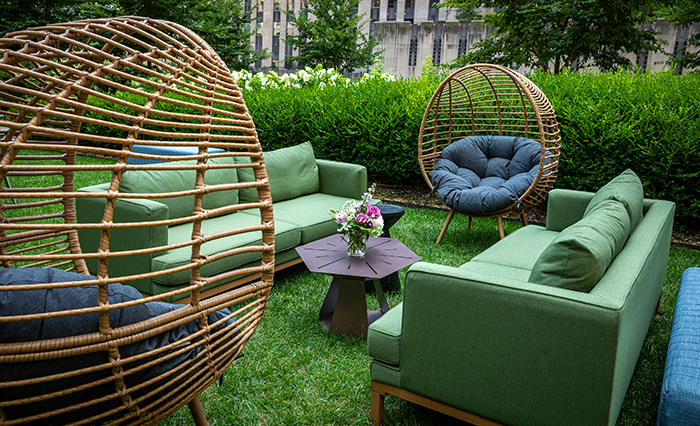
Dana said that there’s a greater effort than ever for events to bring in some element of the outdoors, no matter the market or time of year. For example, the Las Vegas Convention Center is adding an outdoor plaza to the facility’s Legacy Campus, Dana noted, as part of a $600 million renovation that’s expected to conclude in 2025. And that’s after tacking on a 20-acre outdoor exhibit area to the convention center back in 2017, as TSNN previously reported.
But for destinations that simply can’t make an alfresco affair in winter a reality, Dana said that the focus on the outdoors comes in the form of a greater focus on sustainability. To address that, CORT has adopted a circulatory model that sees the company refurbishing already-rented furniture, then selling it at its retail centers so it doesn’t end up in a landfill.
2. A focus on luxe, VIP experiences
Dana recognized that budgets have changed in recent years; however, companies “will spend the money to get the objective for the event,” he said. To capitalize on this, CORT has been promoting VIP seating for large conferences—an area in the front that has soft seating, Dana explained.
“Most conferences at a hotel ballroom are using ballroom seating, which is, you know, small chairs lined up. But what we promote is the idea of VIP seating in the front, which encourages people to actually come to the front,” he said, joking that nobody usually wants to sit in the first two rows.
An added benefit besides some extra comfort: “You can sell sponsored areas in VIP locations up in the front,” Dana said, noting that CORT has already successfully tested this type of sponsorship at the NACE Conference—for the National Association for Catering and Events—in Denver in late July.
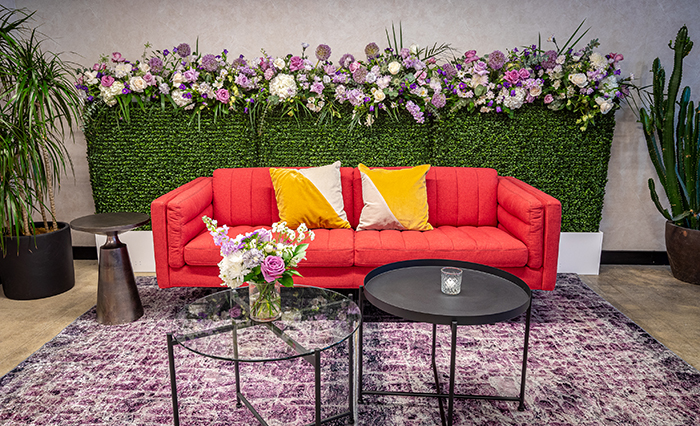
For event professionals looking to get inspired by this sponsorship option, Dana explained that NACE’s conference theme was “seasons,” so CORT constructed four VIP seating areas in colors that nodded to spring, summer, winter, and fall, and NACE was able to sell each of those vignettes as VIP seating.
“It’s another way to generate revenue from sponsors, and then it’s a way to treat your VIPs and VIPs,” Dana continued, adding that CORT first leaned into its focus on luxe offerings for important guests during the pandemic. At the time, an individual-yet-comfortable seat with its own side table and power source was valuable real estate to come by, so offering it was that “extra effort” that’s important for companies to show to a potential client, beloved partner, or vendor they’re looking to impress, Dana added.
Lately, though, Dana said that companies are increasingly ditching single-seating options in these VIP areas for sofas or loveseats, as these seats foster impromptu meetings, which attendees are craving, while still providing comfort.
3. Personalization
“It’s going to continue to be more important—extremely important—for the next few years,” Dana said of personalized elements in event furniture and decor. “As our clients get more sophisticated, they’re all looking for something that’s more, that’s custom, that’s personalized to their own brand. And they all want to do something different.”
As a result, CORT now offers a plethora of customization options, including personalized tabletop decals, bars special-designed with unique logos (or with LED lights in a brand’s signature colors), as well as custom chair upholstery that just zips on. CORT has also recently introduced step and repeats, accent lighting, and drapery in an effort to be a one-stop shop for many event decor needs where personalization is typically requested.
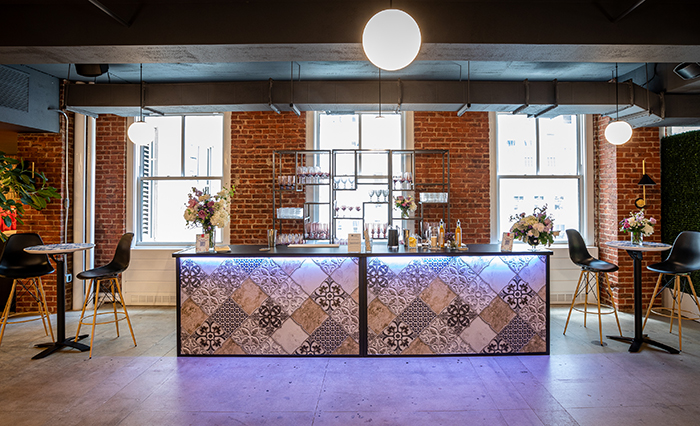
And for items that can’t be personalized, CORT has put an increased focus on modularity in order to still make a piece of furniture feel custom, Dana said, pointing to its Chelsea collection. Many of CORT’s chairs in the collection that can’t boast a company logo, for example, have seating options available in 10-plus colors with interchangeable styles and bases. “For a trade show especially, it’s important to be able to offer a range that’s big enough so customers don’t have to go out and buy something. They can rent something, and then that’s better for the environment,” Dana added.
Speaking of the added sustainable benefits of modularity, Dana said that CORT also offers personalized slipcovers, which customers can keep and reuse long after a rented piece of furniture is returned and continues in its circulatory model.
4. Powered furnishings
One thing that hasn’t gone away at corporate meetings, events, and trade shows is the need for attendees to remain connected. Despite setting auto-response “OOO” emails, there’s typically always a need for guests to check their email or log into their drive to access files. In the past, this need has required that guests leave where all the action is to find an outlet.
However, CORT is now offering plenty of furnishings—including a range of dining and cafe tables, accent tables, and even soft seating options—equipped with outlets, Dana said. This means that attendees don’t have to leave the main to-do to get online or charge their devices. “And anytime you can create a space in a booth or exhibit where you can have an attendee come in and sit for a while, linger, maybe charge their phone, that's good, because then you get to talk to them for longer,” he said.
5. Focus on functionality
“While people typically have an aesthetic and design in mind that’s inspired by a theme or brand, it’s actually the functionality right now that’s more important,” according to Dana, who said that CORT is increasingly asking its customers, “What is the goal for that event?”
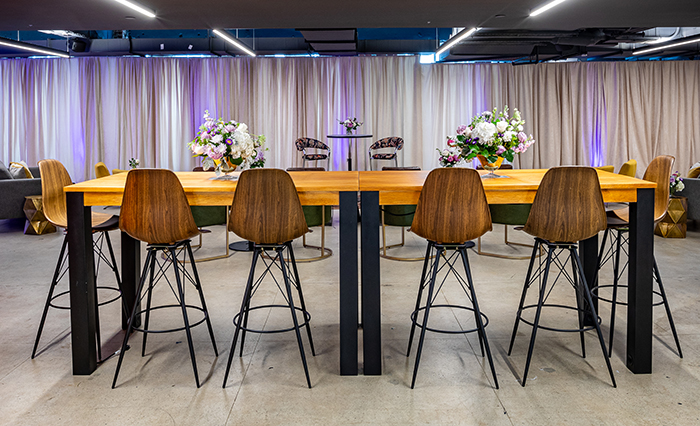
Though design will always be important, “planners are being more intentional about how they set up spaces to make sure they’re addressing all the different needs of their attendees, because everybody is at a conference or meeting for a different reason, and that can change during the day.” As a result, Dana said that rather than receiving specific requests for themed furnishings, for example, CORT is being asked to arrange quiet working spaces, broad networking spaces, and corners arranged to accommodate fireside chats as well as one-on-one meetings—all for a singular event.
When asked how furniture can be arranged according to objectives, Dana offered: “If you’re going to use stand-up bar tables, for example, if you don’t put bar stools by them, then people are more likely to come around, congregate, and network. But if you just put four bar stools around it, four people are going to sit there and probably aren’t going to move around as much.”
All photo credit: Hechler Photographers
Don’t miss any event-related news: Sign up for our weekly e-newsletter HERE, listen to our latest podcast HERE and engage with us on LinkedIn!


Add new comment